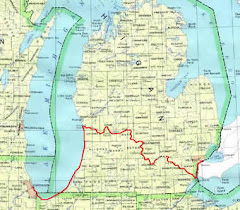 Analyzing the two poems:
Analyzing the two poems:Two differences between Longfellow's epic and Schoolcraft's "Birchen Canoe" struck me (1) Schoolcraft's rhymes while Longfellow's has rhythm. (2) Longfellow's Hiawatha used Larch/Tamarack roots to lash his canoe while Schoolcraft's Birchen Canoe lashings were of fir roots.
Different from either was Schoolcraft's "Canoes of Bark" description in which the lashing roots were cedar.
Curious about the differences I decided to do a less-than-comprehensive search of the canoe literature to see what the experts say or use.
Ontario birch-bark canoe builder Tom Byers uses jack pine roots.
New York Forest Ranger Gary Hodgson's canoe, which he built himself and uses on the job in the Adirondacks, is lashed from roots of the white spruce.
Michigan's Tim Kent in his 1997 two-volume study "Birchbark Canoes of the Fur Trade" says black spruce roots were the most favored for lashing, followed by tamarack/larch. White cedar roots were sometimes used as were those of the white spruce and red spruce.
Adney and Chapelle in their "Bark Canoes and Skin Boats of North America" have black spruce as the root most used. Other roots used according to them were white cedar, tamarack and jack pine.
Henry Vaillancourt, the subject of author John McPhee's "Survival of the Bark Canoe", was being interviewed in 1984 for a "Field and Stream" article. As he lashed a canoe he said, "These are spruce roots, they're not quite as nice as cedar."
I have found no endorsement for the use of "the fir's thready roots" for lashing as set forth in Schoolcraft's 1826 poem.
What do the two poems have in common rather than the use of birch bark and cedar?
Longfellow's last words about the canoe are:
"Like a yellow leaf in autumn,
Like a yellow water-Lilly".
While the last line of Schoolcraft's poem from 30 years earlier is:
"And our bright yellow birchen canoe".
Now a newly made canoe is a thing of beauty but its color is hardly bright yellow, tan maybe, or beige or chestnut brown but not yellow. I think what we have here is what is called "poetic license". After all, how would a poem sound that said, "like a tan leaf in autumn" or a "beige water-lilly" or "our bright brown birchen canoe"?
In his book "The Open Canoe" Bill Reviere says:
"Those who see a birchbark canoe for the first time are often surprised that the bark is reddish-orange in color, not white. That's because the inner surface of the bark becomes the outer surface of the hull, so the familiar white faces into the canoe. This provides a smoother outer finish."
Another thing about color: In the second line of the very first stanza I that I have quoted Hiawatha speaks of yellow bark...."Of your yellow bark, O Birch tree!"
and a few lines later..."Lay aside your white-skin wrapper". I have no explanation. .
This all reminds me of an item I found while reviewing the canoeing literature that has always puzzled me. In her book "The Voyageur" Grace Lee Nute says, "In what dim age Algonquin tribes learned the secret of making canoes from the rind of the yellow birch is not known". There is a yellow birch (betula lutea), one of the largest hardwoods in northeastern North America, but hers is the only reference of which I am aware that infers its bark was widely used for canoes.
On the matter of the paper birch for canoes Adney and Chappelle say:
"The bark of the paper birch (betula papyrifera) was preferred for canoe building....Birches other than the paper birch could be used, but most of them produced bark that was thin and otherwise poor, and was considered unsuitable for the better types of canoes".
I think I should stop here. I could go on and wonder whether Hiawatha's magical canoe used cedar boughs for ribs and didn't need any sheathing between bark and ribs or whether Longfellow deliberately ignored such details for poetic reasons. It is plain he would have been aware of them from studying Schoolcraft, but I've already over-analyzed the poem so I'm going to quit speculating and re-read it just for pleasure. I urge you to do the same.
NEXT: Supplementary remarks


No comments:
Post a Comment